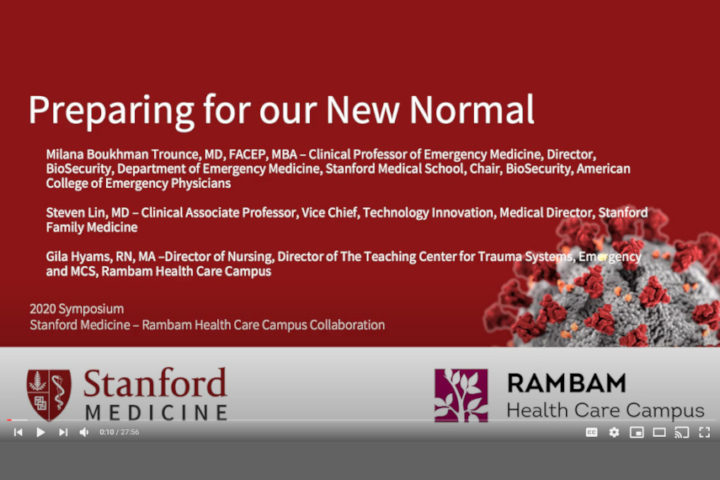The COVID-19 pandemic has negatively affected travel worldwide. This has impacted families, business, and medical research collaborations. Digital meetings have become essential for staying in touch. Hence, the annual Stanford Medicine-Rambam Health Care Campus Symposium was held live – online this year on a particularly relevant topic: Disaster Preparedness and Lessons Learned from the First Wave of COVID-19.
 One of the presentations given during the online symposium.
One of the presentations given during the online symposium.
Rambam Health Care Campus and Stanford Medicine (California, USA) have been holding annual meetings as part of a strategic collaboration that leverages Rambam’s experience with Stanford Medicine’s capabilities. The objective of this year’s annual meeting was to establish an exemplary model for healthcare under extreme trauma conditions that incorporates advanced digital technologies and state-of-the-art methodologies. Both institutions aim to meet the new challenges presented by COVID-19 by innovating an efficient, comprehensive, and systematic mass trauma response framework with the goal of generating an approach that can be deployed worldwide at similar regional Level 1 trauma centers.
This year, face-to-face meetings were not an option. Hence, the symposium was held live, online, over three consecutive evenings (November 9-11, 2020). Considering current events, the agenda focused on the critically important issue of Disaster Preparedness and Lessons Learned from the First Wave of COVID-19.
Rambam’s Professor Rafi Beyar, who helped initiate this cooperative effort, explains that this year’s Stanford Medicine and Rambam Symposium was part of the strategic collaboration between both institutes. The focus on emergency preparedness had already been selected and scheduled by the end of 2019. However, with the advent of COVID-19, the symposium turned into an international webinar and was expanded to include preparedness for COVID-19. He explains, “It was an unprecedented march of great lectures presenting experiences from both sides of the ocean in dealing with the pandemic. Dr. Lloyd Minor and Dr. Michael Halberthal who led the Stanford and Rambam teams, respectively, are to be commended. I am pleased that the three days of presentations were recorded and are available for the benefit of the public.”
About the Stanford Medicine-Rambam Collaboration
The multifaceted Stanford Medicine-Rambam collaboration combines health care delivery and engineering-oriented research and innovation with advanced training of tomorrow’s leaders in medicine and biotech — all commonalities held as core values by both institutes.
Although this year’s meeting focused on disaster preparedness and COVID-19, the collaboration promises to impact medical practices worldwide. Key priorities of the collaboration include:
- Innovations in Health Care with the aim of developing educational programs that promote innovations in medical technologies and drug discovery, with Stanford leveraging existing programs to accelerate innovation at Rambam.
- Advancing Mass Trauma Organization by joining forces to improve the treatment of trauma victims, enhance trauma treatment organizational systems, and more effectively utilize technology.
- Leveraging Digital Health and Big Data by collaborating on big data analysis and approaches to machine learning using existing datasets available within Rambam.
- Innovative Cancer Management is being pursued via the bi-institutional exchange of oncologists and administrators to collaborate on development of even more effective care systems for patient-centered high-quality care.
- Actualization of Cardiovascular Stem Cell Research by collaborating on cardiovascular stem cell-based research, including personalized genetic approaches to treatment of adult cardiovascular patients and children with genetic arrhythmogenic disorders.
Dr. Michael Halberthal, the Director General of Rambam believes that this collaboration will have an immense impact on healthcare, innovation, and tomorrow’s physician-scientists. He said, “This year’s symposium reflected the vision for both of our institutes to brainstorm and fine-tune our responses to the COVID-19 challenges facing us and the rest of the world.”
Learn More About the Stanford Medicine-Rambam Collaboration
View the Entire Symposium on YouTube
Welcome to the Stanford Medicine-Rambam Symposium

